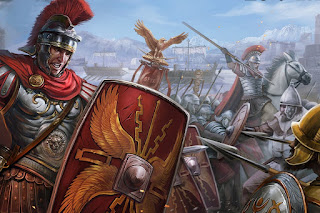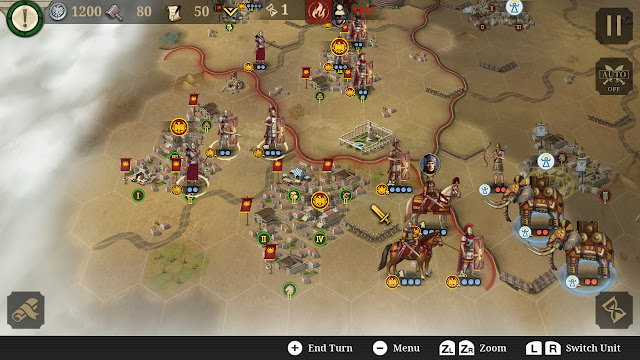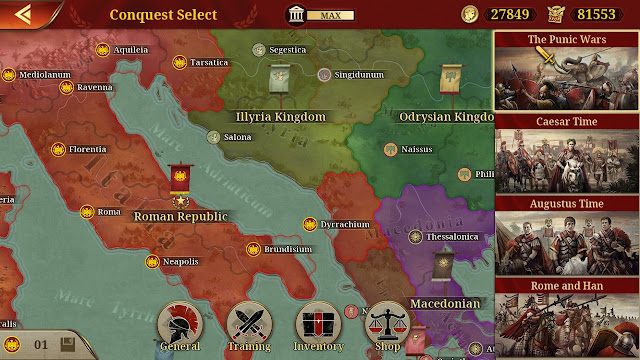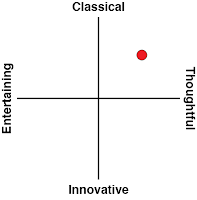For over a decade Chinese developer, EasyTech, has made an art form out of managing the delicate balances required to make a strategy game on mobile devices work. From the World Wars to Napoleon’s campaigns, and all the way back to Three Kingdoms-era China, the company has managed to craft genuine strategy games for iOS and Android that might not have the depth and complexity of a Slitherine or Paradox Interactive masterpiece, but nonetheless manage to offer real strategy in a highly accessible format – think Advance Wars, but drawn from real histories. Courtesy of Circle Entertainment, we already have two of EasyTech’s efforts on Nintendo Switch. One that looked at World War 2, the other at Napoleon’s wars. For the third, we go right back to Rome.
Great Conqueror Rome is ridiculously packed with content, for a start. There are over a dozen campaigns, each offering plenty of linked battle maps together. Then there’s the Conquest mode, where you take control of one of the factions from a couple of different points in Roman history and need to conquer the entire “known world.” Here you can play as one of the super-powers (for example Rome, Carthage), or challenge yourself by playing a minor state and try and beat back the overwhelming forces that come to conquer you. Then there’s “Expeditions”, which play out a little like board games, challenging you to make your way across a number of maps without replacing units, and try to get to the end before attrition gets to you. Any of these modes in isolation would be dozens, and dozens of hours worth of play, making Great Conqueror one of the most packed titles on Nintendo Switch right out of the box.
Now with that being said, just as with the two predecessors on the Switch, Great Conqueror does lack in terms of conveying the history that it depicts. For one thing, you purchase generals with (in-game) cash that you earn from successful battles, but can then assign those generals to units of a different nation if you’d like. They have their real names (and it’s quite obvious that it’s a general from, say, Gaul or Rome just based on the name and costuming), but there’s no real detail on those generals either, leaving you to need to hit up Google if you’re interested in learning more. The same goes for the military campaigns and battles. They’re based in real history, but there has been no meaningful attempt to tie them to real history.
This is a fundamental (and important) difference between Great Conqueror and, say, Civilization or Total War. It’s a very fine difference, but where those games went out of their way to trumpet the historical context, Great Conqueror is quite comfortable with being seen purely as a game, with a bunch of gameplay mechanics and challenges, rather than a recreation of historical nations, forces, personalities, locations and events.
On a personal note, this actually was a bigger issue for me with Great Conqueror than the previous two games. I am very familiar with the wars, battles, politics and “narrative” of both World War 2 and the Napoleonic Wars, meaning that with World Conqueror and European Conqueror, I was able to “fill the gaps” so to speak, and add my own context into events that the game wasn’t overly interested in explaining. When a nation would offer to join the war effort early (or delay their entry into the war) in exchange for some resources, I knew the implications of that decision less because the game gave me a reason to compare that a nation was trying to twist my am to give up my precious resources, and more because I simply knew the role that nation played in the war, and whether they were worth worrying about.
My knowledge with Roman history is much (much) more spotty. Aside from being a big-time fan of Caligula, who isn’t even an unlockable general in this game (oh c’mon… are you in any way surprised I stan Caligula?), and knowing the more popular stories of Cleopatra, Brutus, Nero and so on, my understanding of Rome and its many, many dramas, is both spotty and limited. I knew Hannibal did the thing with the elephants to invade the Roman territory, for example, but I don’t know much more than that when it comes to specifics. It’s a gap in my knowledge that I really should fill, I am aware of that, and were Great Conqueror more like, say, Civilization, it may well have helped put me on that path, but it’s not going to do that. I didn’t even come out of my time with the game with a better understanding of where to start learning more.
In fact, once you’re digging into command abilities such as directing arson attacks on cities, carefully building up fortifications to protect units in key spots, and dealing with Fog of War, Great Conqueror does show that it has some real strategic teeth. It never stops looking accessible, with nice, Advance Wars-style animations depicting battles and showing the slow attrition to a unit as it fights in more battles and sheds soldiers. Furthermore, the interface is very straightforward and accessible. You’ll learn how to play Great Conqueror in just minutes, and given that this genre almost loves how inaccessible it is, that comes across as a breath of fresh air. In short, if there were any games that I would immediately recommend to people looking to step up into military strategy games, it would be EasyTech’s work. Finally, but not insignificantly, Great Conqueror has the benefit of having a more colourful and vibrant range of unit types, and the exoticism of ancient history swords-and-sandals combat that helps to give it the slight edge, visually, over the more modern tones of the other two EasyTech strategy games on Nintendo Switch.
At this point, EasyTech strategy games are a known quantity on Nintendo Switch. They’re light, streamlined strategy games, however, they also avoid the pitfalls of many other strategy titles developed for mobile first. They aren’t condescending to the player’s intelligence, and are willing to challenge and even “beat” poor play. Furthermore, they don’t rely on unbalanced mechanics to determine victory like is standard for free-to-play titles. I am disappointed that the history is such a light brush that it’s barely present and I walked out of Grand Conqueror Rome with little better understanding on where to begin learning about ancient Rome than I had going in, but for most people that won’t be an issue. What they will get is more than enough tactical strategy action to last them for many months to come.
– Matt S.
Editor-in-Chief
Find me on Twitter: @mattsainsb
The critic was provided with a copy of this game for review.











